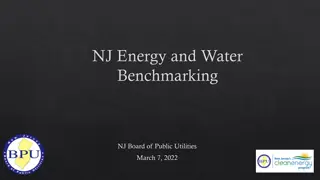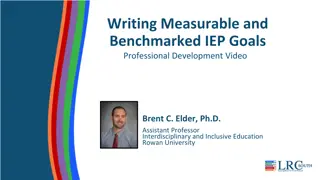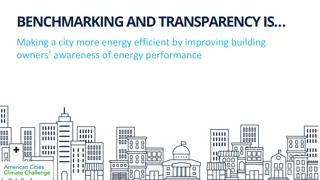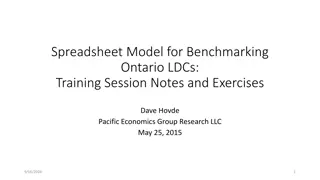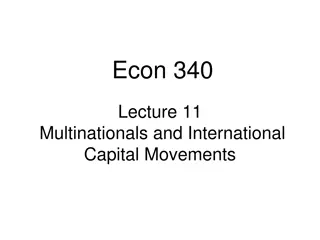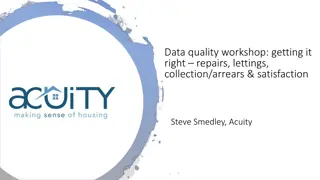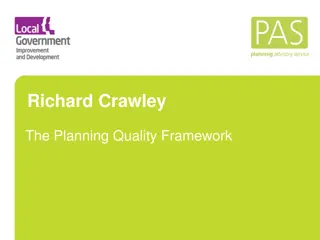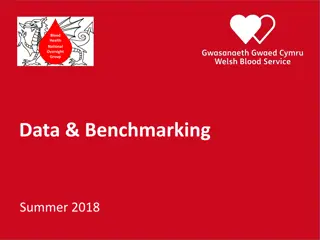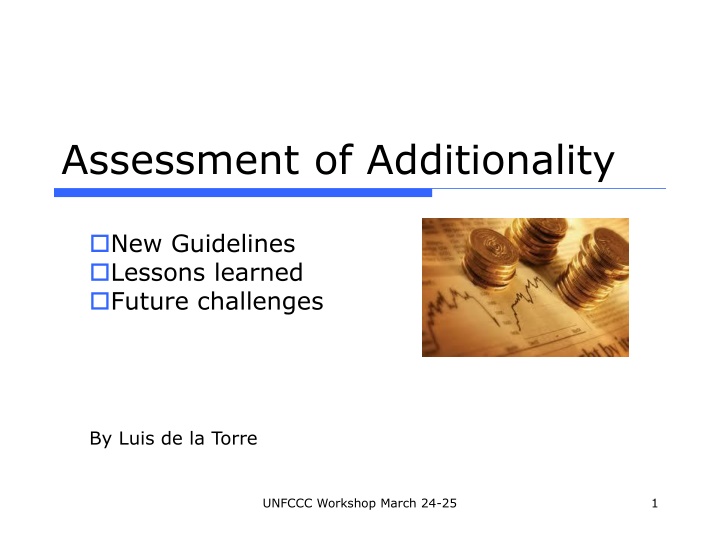
Challenges in Financial Benchmarking for Multinationals
Financial benchmarking and its standardization are crucial issues affecting multinational corporations and financial institutions. This article discusses the challenges faced in assessing additionality and provides insights into investment analysis guidelines, capital budgeting parameters, and macroeconomic indicators. Explore the complexities of assessing macro/micro indicators standardization and the impact on registration processes for projects under the UNFCCC Workshop.
Uploaded on | 0 Views
Download Presentation

Please find below an Image/Link to download the presentation.
The content on the website is provided AS IS for your information and personal use only. It may not be sold, licensed, or shared on other websites without obtaining consent from the author. If you encounter any issues during the download, it is possible that the publisher has removed the file from their server.
You are allowed to download the files provided on this website for personal or commercial use, subject to the condition that they are used lawfully. All files are the property of their respective owners.
The content on the website is provided AS IS for your information and personal use only. It may not be sold, licensed, or shared on other websites without obtaining consent from the author.
E N D
Presentation Transcript
Assessment of Additionality New Guidelines Lessons learned Future challenges By Luis de la Torre UNFCCC Workshop March 24-25 1
Assessment of Additionality Challenges for an old topic Financial benchmarking and its standardization is a common issue in most multinationals and financial institutions to accelerate the decisions and assure a minimum level of quality (risk) The financial target is not the only value that is commonly treated as default values, all the parameters of capital budgeting are normally treated in this way as policy. The values can change significantly or stay static for long term according to the context where they are used. For CDM projects, this is a critical issue that affects the registration process as delays or rejection UNFCCC Workshop March 24-25 2
Assessment of Additionality The new Guidelines on the assessment of investment analysis After consultations, the Meth Panel could recommend EB a set of default values for cost of equity computation of WACC (e.g. 0.5/0.5 rule for Greenfield project, use of taxes among others). This approach is optional signatories of Kyoto Protocol. International accounting regulations such as IFRS and USGAAP currently covers WACC calculations but the approach for the CDM market is truly pioneer and gives the message of feasibility of more standardization of other parameters to improve the registration process and monitoring (reduction resources). two years of discussions and global and rules for and covers all countries in time and cost of UNFCCC Workshop March 24-25 3
Assessment of Additionality The whole picture in capital budgeting Macroeconomic parameters Inflation GDP growth and demand Exchange rates Microeconomic parameters Fiscal issues Capital composition Books and investee positions Financial target Risk acceptance Capital budgeting UNFCCC Workshop March 24-25 4
Assessment of Additionality Example of some issues affecting macro/micro indicators standardization The concern of recent meltdown in 2008 and future return of the market, not very linear The concept of strong currency as benchmark due to the crisis for USD or Euros The accounting rules seen as very complex and different in many context, specially the discussion on rules for SMEs and large Corporations. The complexity of validating adjustment in prices in time contracts as electricity or fuels) inflation (e.g. and currency delivery energy UNFCCC Workshop March 24-25 5
Assessment of Additionality Some answers: long term view Long term analysis of economic parameters have been definitely key to get consensus on default values for cost of equity. UNFCCC Workshop March 24-25 6 Source: Elroy Dimson, Paul Marsh, and Mike Staunton, LBS 2006
Assessment of Additionality Some answers: Accounting All accounting Books and following market regulations to avoid discussions on investee positions if the financing is structured from a headquarters, basically using the risk exposure as general rule. CDM projects are based on legal entities with Hosting many assets Hosting only CDM Project CDM Debt 10 MM Debt 300 MM CDM Assets 20 MM Assets 500 MM Equity 200 MM Ke=20% CDM Equity Ke= 14% UNFCCC Workshop March 24-25 7
Assessment of Additionality Some answers: Country risk/risk free rate There are many companies with reputation and tradition in calculating Country Risk and years of data. All are good but a decision was construction of default values. The use of US T-bond indexed to inflation was another decision of a paper with excellent tradition in the largest market, even in times of severe crisis such as 1929, WW1-2 or 2008 Meltdown. made to facilitate the UNFCCC Workshop March 24-25 8
Assessment of Additionality Future challenges (1) : business plan guidelines Most CDM project financing define sales based on PLF, no ramp up with strong rationale and weak proposals of demand. Prices are also presented as flat all over the crediting period with no consideration of effect of exchange rate for raw materials or price in final consumers. The depreciation of assets is another point considered flat in most analysis even there are specific rules according to the type of asset and this affects the tax shield position. Fiscal rules also changes in most countries and this is difficult to asses by DoEs UNFCCC Workshop March 24-25 9
Assessment of Additionality Future challenges (2) : business plan guidelines The answer to this is more standard guidance and now there are conditions to create better rules to give clear and fair values to all countries without exception. Thinking in a systemic approach, a universal template in a spreadsheet running macros and updated to a official UNFCCC database of parameters is possible and will help to increase the flow of controversies with DoEs and timing for registration. Moving forward, it is possible to open a discussion to incorporate risk assessment projects and reduce the UNFCCC Workshop March 24-25 10
Assessment of Additionality Decisions based only on IRR Example: financial return of Power generation Projects 18% 16% 16% 14% 14% 12% 12% 10% 10% IRR % 8% 6% 4% 2% 0% Coal Natural gas Biomass Wind Mill UNFCCC Workshop March 24-25 11
Assessment of Additionality Decisions based on Risk and Value generation Minimum risk 90 80 70 60 Coal Natural gas Biomass Wind Mill Risk Score 50 40 30 Best choice 20 10 0 0 2 4 6 8 10 12 14 16 Net Present Value MM USD Highest value generation UNFCCC Workshop March 24-25 12
Assessment of Additionality Final Remarks Today the level of financial data for most countries and industrial sectors is enough to develop more standard approaches in the analysis of risk and return. A long run analysis is consistency of the values NAMAs should be developed in parallel with the financial information of the countries market. No doubt this approach will have a very significant impact in the fairness and transparency of business related to CDM plus the advantage of a higher flow of better projects. mandatory to assure the related to the carbon UNFCCC Workshop March 24-25 13

